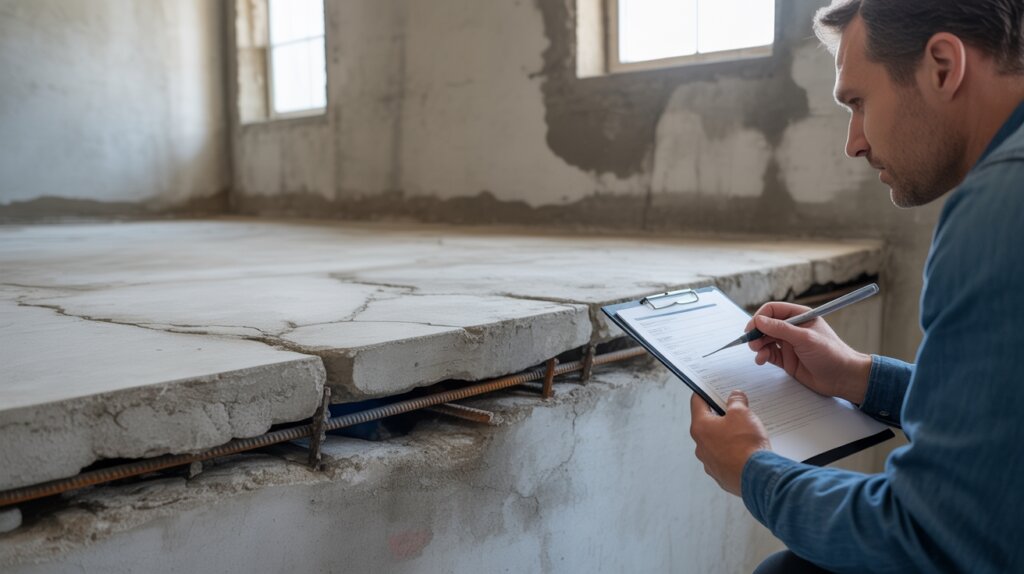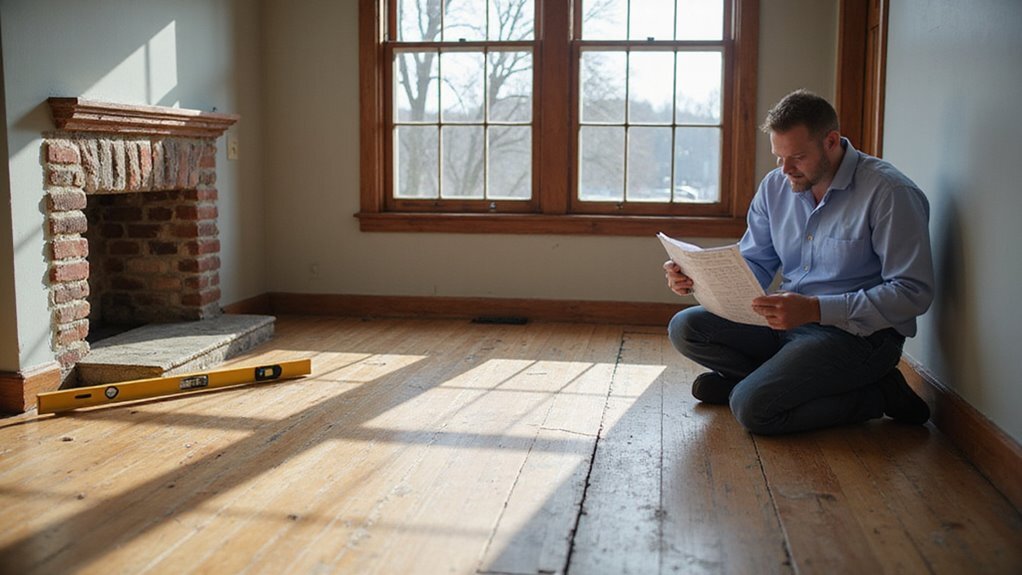Cracks in your walls or floors can be worrying signs of foundation issues. Many homeowners feel anxious when they notice these problems. Not knowing what to do next can make the situation even more stressful.
Ignoring foundation problems can lead to bigger and more costly repairs later. Confusion about structural reports adds to the uncertainty. You might worry about your home’s safety and its value. A structural report explains the causes of foundation problems and guides you on the best way to fix them.
This report can give you clear answers and peace of mind. Knowing what to expect helps you make smart decisions. This blog will guide you through understanding and using a structural report for your home’s foundation issues.
What Is a Structural Report?

A structural report is a document that explains the condition of a building’s structure. It is created by a qualified structural engineer. The report checks if the house is safe and strong. The engineer examines important parts like the foundation, walls, and framing. If there are problems such as cracks or uneven floors, these will be noted.
The report may also mention if soil issues are making the structure unstable. You will get a clear summary of what the engineer finds. The report may include photos, diagrams, and suggestions for repairs. If you need to fix something or sell your home, this report can help you decide what to do next. Understanding foundation issues is essential for assessing overall home safety and value.
For homeowners facing financial distress, obtaining a comprehensive structural report can be a valuable step before selling, especially when considering options like cash homebuyers who purchase homes as-is without requiring repairs.
Signs Your Home May Need a Structural Assessment
Your home may need a structural assessment if you notice certain warning signs. Cracks in walls, ceilings, or floors should be watched closely. If these cracks get bigger, it could mean a problem is growing.
Doors or windows that suddenly stick or do not close right may show shifting in your home. Uneven floors or gaps between walls and ceilings can also be signs of trouble. Visible separation at the baseboards often points to foundation issues.
Frequent water pooling around your home can weaken the soil under your foundation. If you see water collecting often, you should be concerned. Past repairs to the foundation that are failing are another warning sign. Proper foundation management includes understanding the probate process if the property is part of an estate, which can impact repair timelines and costs.
If you notice any of these problems, consider getting a professional structural assessment. Do not ignore these issues. Early action can prevent bigger and more costly repairs. Proper documentation and understanding of potential title issues can also help when seeking repairs or selling your home.
Who Can Perform a Structural Report?

A structural report should be done by a qualified professional. Only a licensed structural engineer has the right training for this task. If you need a structural report, do not hire a general contractor or home inspector for it. Ensuring the property has a clear title is also essential for a smooth sale process. Structural engineers have a degree and a license. They know about foundation materials and local building codes.
Their reports are trusted for safety and legal reasons. General contractors may have a license, but they cannot write official structural reports. Home inspectors can find problems but are not allowed to make structural reports. Always check credentials before hiring anyone for this job. Recognizing the importance of proper assessment methods can help prevent future issues and ensure accurate evaluations.
Key Components of a Structural Report
A structural report explains the condition of your home’s foundation. It describes what the inspector checked and what they found. You will know the type of construction, the age of the home, and any changes made.
The report lists visible problems like sloping floors or doors that do not close. It also describes cracks in walls, ceilings, and foundations. Diagrams or photos will show where these issues are. A structural report highlights visible issues such as sloping floors, sticking doors, and cracks, illustrated with clear diagrams or photos.
Inspectors include the methods they used for checking the foundation. They will also mention if there were any limits to what they could inspect. If any part could not be checked, the report will state this clearly. Foundation inspection methods can help you understand how thorough the assessment was.
You will get an explanation of possible causes for the damage. The report rates how serious the problems are. It ends with simple advice for repairs or future checks.
If you follow the report’s advice, you can make better decisions about your home. Understanding foundation problems and their impact can help you prioritize repairs and maintain your property’s safety and value.
Common Foundation Issues Identified in Reports

A structural report lists foundation problems that can affect your home’s safety and value. Common findings include wall or floor cracks, uneven floors, and water leaks. These problems often mean the foundation is weak or damaged. Recognizing these issues early can help prevent costly repairs later.
Inspectors may find crumbling concrete, broken bricks, or worn stone. Shifting soil or water damage can make these materials worse. If gaps appear between the house and the foundation, movement may be happening. Understanding foundation deterioration can help you assess the urgency of repairs needed.
A report also checks if your home meets building codes. Outdated methods or poor materials are flagged for repairs. Recognizing different types of liens involved in property issues can help you understand the scope of repairs needed. If you understand these issues, you can plan repairs and protect your home.
How Structural Engineers Evaluate Foundation Problems
Structural engineers check your foundation by looking for signs of trouble and finding out what caused them. They inspect cracks, uneven floors, and doors that stick. This helps them decide how serious the problem is. They also assess the home’s curb appeal, as exterior conditions can sometimes indicate underlying issues. Engineers figure out how much the foundation has moved and where. They study the pattern of settlement to locate the source. If the problem is severe, they look at building plans and past repairs.
They also check how water drains around your home. Poor drainage can lead to foundation issues. Engineers may use tools or old soil reports to learn about the ground under your house. Their inspection combines what they see with technical details, including soil stability, to ensure a comprehensive evaluation. If needed, they suggest repair options based on their findings. These steps make sure you get the right solution for your home.
The Importance of Soil Analysis
Soil analysis is important because the ground supports your home’s foundation. Unstable soil can cause the foundation to move or crack. If you want a safe home, you need to know what is under it.
Soil testing helps identify the type of soil, such as clay, sand, or loam. Each type reacts differently when holding up a house. If you skip this step, you may miss hidden risks.
Moisture in the soil can change over time. These changes might make the soil expand or shrink, which affects the foundation. If soil holds too much water, it can lose strength. Proper soil assessment is essential for preventing future foundation damage.
Compacted soil is stronger and provides better support. Loose or poorly compacted soil can let a foundation sink or shift. If the soil is not well compacted, problems can happen. Identifying soil compaction levels helps assess the stability of the ground.
A geotechnical expert can check all these factors. If you want to fix foundation issues, you must know the real cause. Soil analysis gives you the right information to solve the problem.
Costs Associated With Structural Reports
A structural report for a home with foundation problems can be costly. The report cost depends on several key factors. These include your home’s size, age, and location. Having a clear title can also influence the overall process and costs involved in addressing foundation issues, as resolving legal and ownership concerns beforehand can streamline inspections and repairs.
Most homeowners pay between $500 and $1,500 for a standard report. Costs may rise if the engineer must perform special tests or detailed analysis. Extra charges can apply if the engineer needs to return for more inspections. Choosing a qualified engineer with clear pricing can help you avoid surprises. Knowing these costs helps you plan your budget better.
How to Prepare for a Structural Inspection
To get accurate results from your structural inspection, start by gathering all relevant property documents, such as past repair records and blueprints. Make sure inspectors have clear access to the foundation by moving furniture and removing debris. This preparation helps the inspection run efficiently and ensures nothing important gets overlooked.
Gathering Essential Property Documents
Gathering essential property documents helps your inspector understand the home’s structure and history. These records make the inspection smoother and more accurate. If you organize them before the inspection, you will save time and avoid confusion.
Original building plans or blueprints show the foundation layout and any changes made. Prior repair or assessment reports point out recurring problems and past solutions. Property maintenance logs or receipts track improvements or changes that could impact the foundation.
If you collect these documents, you give the inspector a complete view of your property. This helps them find the root cause of issues more quickly. Providing these records also shows you care for your home.
Clearing Access to Foundation
To clear access to your foundation, remove anything that blocks the inspector’s path. Move furniture, boxes, and plants away from crawl spaces or walls. If the inspector cannot reach an area, they may miss important issues.
Trim shrubs and pull back soil or mulch from the exterior walls. Make sure all vents, doors, and panels can open easily. If these are locked or stuck, the inspection could be delayed.
Proper access helps the inspector check the entire foundation. This preparation increases the accuracy of your structural report. If you prepare well, you will avoid delays and missed problems.
Understanding the Findings in Your Report
When you read your structural report, you’ll notice it highlights common foundation defects and assigns severity ratings to each issue. These ratings help you understand which problems need urgent attention and which are less critical. Knowing how to interpret these findings lets you prioritize repairs and plan your next steps effectively.
Common Structural Defects
Technical language in a structural report explains the main problems with your home’s foundation. Most reports focus on issues that can harm your house’s stability. If you understand these terms, you can decide what to fix first.
Foundation cracks are a common problem. They may be thin lines or large gaps in the concrete. If you notice them, your foundation might be shifting.
Uneven floors can show up if the ground under your house moves. These floors may slope or feel soft when you walk. You should check for this if your floors no longer feel flat.
Wall separation is another sign of trouble. Gaps can form between walls and ceilings or doors may stick. If this happens, the soil under your house may not be stable.
Severity Ratings Explained
Severity ratings show how serious each structural defect is. These ratings tell you how quickly you should fix a problem. Your structural report uses these ratings to help you decide what to do next.
A defect like foundation settlement can be minor, moderate, or severe. The severity depends on how much movement there is and how fast it is progressing. If you see a crack, the report will say if it is only cosmetic, needs checking over time, or needs fixing right away.
The ratings follow industry standards and are based on what the inspector sees and measures. You should use these ratings to decide which repairs need the most attention. If you do not understand a rating, ask your inspector to explain it.
Recommended Repair Solutions Based on Reports
Structural reports recommend repair solutions based on your home’s foundation problems. These repairs aim to fix urgent issues and provide long-term support. Cost estimates are included to help you plan and decide which repairs to do first. Structural reports outline repair solutions for your foundation, prioritizing urgent fixes, long-term stability, and providing cost estimates to guide your decisions.
If your foundation is unstable, underpinning may be suggested. This method uses piers or piles under the house to stabilize it. Underpinning can help level uneven foundations.
Cracks in the foundation might need sealing and waterproofing. Applying waterproof membranes can stop water from getting inside. These steps protect your foundation from future moisture problems.
Some reports suggest drainage improvements if water is pooling near your home. Regrading the soil or adding drainage systems can keep water away from the foundation. Proper drainage reduces the risk of further damage.
How Structural Reports Impact Home Value and Sales
A structural report can affect your home’s value and how quickly it sells. If the report finds problems, buyers may offer less money. Lenders and appraisers also pay close attention to these issues.
Foundation problems often lower a home’s value. Buyers worry about safety and future repair costs. If repairs are needed, lenders might not approve a loan.
Repair records can help buyers feel more secure. Clear documentation may make negotiations easier. Sellers who fix issues may sell faster.
Unresolved problems make a home less attractive. If you leave repairs undone, your home could stay on the market longer. Addressing concerns early can help manage expectations.
Choosing the Right Professional for Your Assessment
To assess your home’s foundation, you need the right professional. A qualified expert will have the skills to spot serious problems. If you choose the right person, your assessment will be accurate and useful.
Look for someone with a license in structural engineering. Their training helps them inspect foundations and understand soil test results. If the professional has handled homes in your area, that is a plus.
Check if they have experience with foundation inspections and soil testing. If they can show sample reports, review them for detail and clarity. Credentials, experience, and clear reporting are key for a good assessment.
Next Steps After Receiving a Structural Report
Once you have your structural report in hand, you’ll need to interpret its findings to understand the extent and urgency of any foundation issues. Use this information to prioritize and plan the necessary repairs, focusing on both immediate concerns and long-term stability. By taking a systematic approach, you can address problems efficiently and protect your home’s value.
Interpreting Report Findings
A structural report explains the condition of your home’s foundation. You need to understand its findings to make smart decisions. The report shows problems, causes, and how serious the damage is.
The report uses words like “foundation settlement,” “cracking,” or “shifting” to describe main issues. If you see these words, there may be structural concerns. Always check the summary if you find technical terms confusing.
Severity levels in the report tell you how urgent a problem is. If an issue is called “moderate” or “severe,” you should act sooner. Minor issues may not need immediate attention.
Read the recommendations section to know what steps are needed. If repairs are suggested, follow them to keep your home safe. Preventative tips can help you avoid future problems.
Planning Necessary Repairs
After reviewing your structural report, make a clear plan for needed repairs. List each problem and decide which to fix first. Always address the most urgent risks to your home’s structure.
Start with the foundation. Fix drainage or moisture issues that could damage it further. If you notice cracks or settling, get expert advice on repairs.
If your home needs extra support, explore options like adding beams or underpinning. Compare estimates from several contractors before choosing one. When you have a plan, schedule the repairs and track the progress.
A step-by-step plan protects your home’s safety and value. If you follow these steps, you can avoid bigger problems later. Always consult professionals for the best results.
Conclusion
If you understand your structural report, you can make better decisions about your home’s foundation issues. Early action and professional advice often prevent costly repairs in the future. Your report is a useful tool for maintaining your home’s value and safety.
If you are worried about selling a house with foundation problems, there are options available. We understand that repairs can be stressful and expensive for homeowners. If you prefer a simple solution, we buy houses for cash in any condition.
If you want to avoid the hassle of repairs, contact OC Real Estate today. We can make you a cash offer and handle the process quickly. Let us help you find the best solution for your situation.

